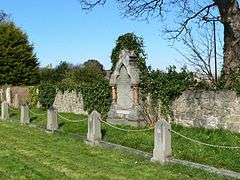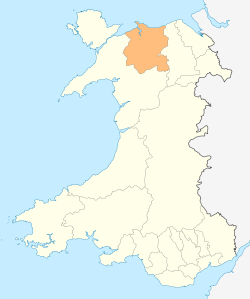Abergele
| Abergele | |
 Memorial to the 33 people killed in the Abergele railway disaster of 1868 |
|
 Abergele |
|
| Population | 10,577 (2011) |
|---|---|
| OS grid reference | SH945775 |
| Community | Abergele |
| Principal area | Conwy |
| Ceremonial county | Clwyd |
| Country | Wales |
| Sovereign state | United Kingdom |
| Post town | ABERGELE |
| Postcode district | LL22 |
| Dialling code | 01745 |
| Police | North Wales |
| Fire | North Wales |
| Ambulance | Welsh |
| EU Parliament | Wales |
| UK Parliament | Clwyd West |
| Welsh Assembly | Clwyd West |
Coordinates: 53°17′N 3°35′W / 53.28°N 3.58°W
Abergele is a community and small market town, situated on the north coast of Wales between the holiday resorts of Colwyn Bay and Rhyl, in Conwy County Borough. Its northern suburb of Pensarn lies on the Irish Sea coast and is known for its beach, where it is claimed by some that a ghost ship has been sighted. Abergele and Pensarn railway station serves both resorts. Abergele is often overlooked due to the popularity of nearby Rhyl, Prestatyn, Colwyn Bay, Llandudno and Conwy.
Etymology
The meaning of the name Abergele can be deduced by aber being the Welsh word for estuary, river mouth or confluence and 'Gele' the name of the river which flows through the town. Gele is a dialectal form of gelau, which means spear, describing the action of the river cutting through the land. It has also been suggested this river is named because its waters flash brightly.
Geography

The town itself lies on the A55 road and is known for Gwrych Castle. The town is surrounded by woodland covered hillsides, which contain caves with rare lesser horseshoe bat. The highest hill is Moelfre Isaf (1040 ft) to the south of the town. There are also outstanding views from Cefn-yr-Ogof (669 ft), Tower Hill (587 ft) and Castell Cawr (known locally as Tan-y-Gopa) which is 189 metres (620 feet). Castell Cawr is an Iron age hillfort, one of several in the area. Dinorben hillfort to the east of town was destroyed in the 1980s.
Abergele (including Pensarn) has a population of around 10,000[1] and is part of the Abergele/Rhyl/Prestatyn urban area with a population of 64,000. Approximately 29% of Abergele has a significant knowledge of Welsh. The town also has satellite villages such as Saint George, Betws yn Rhos, Rhyd-y-foel, Belgrano, Llanddulas and Llanfair Talhaearn.
Pensarn and Belgrano are significantly less Welsh than the rest of town, with 47.7% of people identifying themselves as English in the 2011 census.[2]
History


Abergele was the site of an important clas (Celtic monastery) and remained settled into the 13th century. A "Prince Jonathan of Abergeleu" is listed by the B text of the Annals of Wales as dying during the 9th century reign of Rhodri the Great,[3] although Charles-Edwards has supposed him to have simply been the monastery's abbot.[4] Edward I is known to have briefly stayed there in December 1294 during his invasion of Wales to suppress the revolt of Madog ap Llywelyn.
Sites of historical interest include two Iron Age hillforts; Castell Cawr at Tan y Gopa and Fort Dinorben (now virtually disappeared owing to limestone quarrying) at St. George. On Gallt y Felin Wynt, a hill above the town popularly known as Tower Hill or Bryn Tŵr is a 17th-century watchtower, partially restored in 1930. There is another Iron Age fort at Pen y Corddyn Mawr hill above Rhyd y Foel. There is also another watchtower, the Lady Emily's Tower which is located near Cefn yr Ogof.
Gwrych Castle was built between 1819-25 at the behest of Lloyd Hesketh Bamford-Hesketh. From 1894 until 1946 it was the residence of the Dundonald family.[5] Gwrych Castle's present owner, Californian businessman Nick Tavaglione, who bought the landmark in December 1989 put Gwrych up for auction on 2 June 2006, but it failed to sell. The condition of the property is being monitored by the Gwrych Castle Preservation Trust.[6] It is undergoing renovation.
The boxers Bruce Woodcock (in the late 1940s) and Randolph Turpin (in 1952) trained at Gwrych Castle and the film Prince Valiant, was filmed there in 1996.
A curious undated inscription can be found on a tombstone in St Michael's parish church (built on the site of the old clas). It states "Here lieth in St Michael's churchyard a man who had his dwelling three miles to the north." As the sea is little more than half a mile away at this point, this suggests that the sea has made some considerable advance over the centuries.[7]
Outside the church is a penitential stone where sinners had to do penance by standing, dressed in white, by the stone and beseech the congregation for mercy as they entered and left the church.
In 1868 the Abergele Train Disaster was, up to that time, the worst railway disaster in Britain. The 33 people who died are buried in a mass grave in the local churchyard.
A sanatorium was built just outside Abergele in 1910. In 1914 this was acquired by Manchester City Council. A children's sanatorium was built on the same site. The sanatorium was taken over by the newly formed NHS in 1948 and was closed later, when the introduction of antibiotics made the building redundant.
On 30 June 1969, the evening before the investiture of Prince Charles in Caernarfon, two members of Mudiad Amddiffyn Cymru (Welsh Defence Movement), Alwyn Jones and George Taylor, were killed when the bomb they were planting outside government offices exploded prematurely.

Ethnography
Recent genetic studies as part of the Genetic history of Europe[8] on the y-chromosomes of men in Abergele have revealed that there is a significant percentage of E1b1b1a2 haplogroup in Abergele. Membership in Y chromosome haplogroup E1b1b1a2 (E-V13) was found to average at 38.97% in a small sample of 18 male y-chromosomes in Abergele. This genetic marker is found at its highest concentrations in the Balkans at over 40% in areas, but at much lower percentages in Northern Europe at less than 5%. The reason for drastically higher levels of E1b1b in Abergele is most likely due to the heavy Roman Army presence in Abergele as most of the Roman Soldiers that came to Britain did not come from Italy, rather from other parts of the Roman Empire. Other notable levels of genetic marker E-V13 have been found in a few other towns in Britain that were known to have had a heavy Roman presence nearly 2000 years ago.[9]
Notable people
- David Vaughan, footballer for Nottingham Forest and Wales
- Lisa Scott-Lee (singer with Steps), attended Ysgol Emrys ap Iwan
- Justin Broadrick Musician (Godflesh, Napalm Death)
- Aylward M. Blackman, Egyptologist
- Team Apollo, competitors in the 2016 series of Robot Wars
References
- ↑ Office for National Statistics : Census 2001 : Parish Headcounts : Conwy
- ↑ "Pensarn national identity". neighbourhood statistics. Retrieved December 14, 2014.
- ↑ The Annals of Wales (B text), p. 10.
- ↑ Charles-Edwards, T.M. "The Heir-Apparent in Irish and Welsh Law". Celtica, Vol. 9, p. 180–90. Dublin Institute for Advanced Studies, 1971. Accessed 27 Feb 2013.
- ↑ A brief history of Gwrych Castle, Gwrych Castle Preservation Trust, retrieved 14 March 2009
- ↑ What is the Castle Trust?, Gwrych Castle Preservation Trust, retrieved 14 March 2009
- ↑ Black, Adam and Charles (1857), Black's Picturesque Guide to North Wales, p. 30
- ↑ Y Chromosome Evidence for Anglo-Saxon Mass Migration (PDF), 25 January 2002, retrieved 5 November 2006
- ↑ Bird, Steven (2007), "Haplogroup E3b1a2 as a Possible Indicator of Settlement in Roman Britain by Soldiers of Balkan Origin", Journal of Genetic Genealogy, 3 (2), retrieved 10 November 2008
External links
| Wikimedia Commons has media related to Abergele. |
| Wikivoyage has a travel guide for Abergele. |
- A Vision of Britain Through Time
- Abergele Post
- Abergele Town Council
- British Listed Buildings
- Castles of Wales
- Clwyd Churches: Abergele
- Clwyd Churches: St George
- Eastern Conwy Churches Survey: Abergele
- Eastern Conwy Churches Survey: St George
- Abergele: historical and genealogical information at GENUKI.
- Geograph
- Gwrych Castle
- Gwrych Castle Preservation Trust
- Manchester City Council: Recollections from TB Sanatorium
- Office for National Statistics
- Rhyl, Prestatyn and Abergle Journal
- Wales DNA Project
